曼昆经济学原理答案11—15章
- 格式:pdf
- 大小:969.57 KB
- 文档页数:38
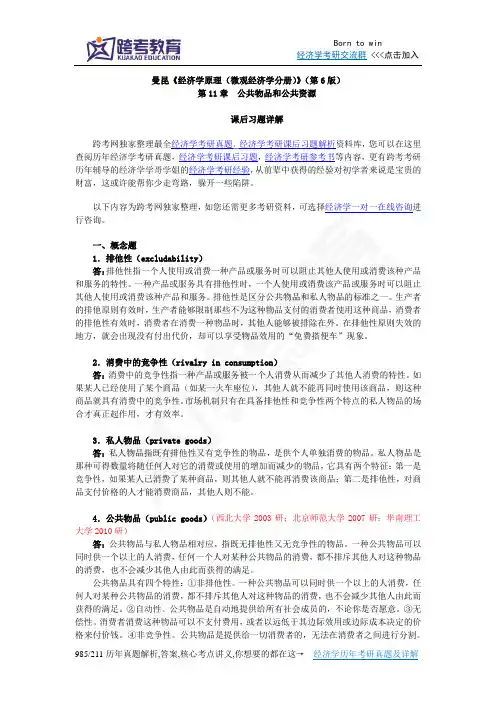
曼昆《经济学原理(微观经济学分册)》(第6版)第11章公共物品和公共资源课后习题详解跨考网独家整理最全经济学考研真题,经济学考研课后习题解析资料库,您可以在这里查阅历年经济学考研真题,经济学考研课后习题,经济学考研参考书等内容,更有跨考考研历年辅导的经济学学哥学姐的经济学考研经验,从前辈中获得的经验对初学者来说是宝贵的财富,这或许能帮你少走弯路,躲开一些陷阱。
以下内容为跨考网独家整理,如您还需更多考研资料,可选择经济学一对一在线咨询进行咨询。
一、概念题1.排他性(excludability)答:排他性指一个人使用或消费一种产品或服务时可以阻止其他人使用或消费该种产品和服务的特性。
一种产品或服务具有排他性时,一个人使用或消费该产品或服务时可以阻止其他人使用或消费该种产品和服务。
排他性是区分公共物品和私人物品的标准之一。
生产者的排他原则有效时,生产者能够限制那些不为这种物品支付的消费者使用这种商品,消费者的排他性有效时,消费者在消费一种物品时,其他人能够被排除在外。
在排他性原则失效的地方,就会出现没有付出代价,却可以享受物品效用的“免费搭便车”现象。
2.消费中的竞争性(rivalry in consumption)答:消费中的竞争性指一种产品或服务被一个人消费从而减少了其他人消费的特性。
如果某人已经使用了某个商品(如某一火车座位),其他人就不能再同时使用该商品,则这种商品就具有消费中的竞争性。
市场机制只有在具备排他性和竞争性两个特点的私人物品的场合才真正起作用,才有效率。
3.私人物品(private goods)答:私人物品指既有排他性又有竞争性的物品,是供个人单独消费的物品。
私人物品是那种可得数量将随任何人对它的消费或使用的增加而减少的物品,它具有两个特征:第一是竞争性,如果某人已消费了某种商品,则其他人就不能再消费该商品;第二是排他性,对商品支付价格的人才能消费商品,其他人则不能。
4.公共物品(public goods)(西北大学2003研;北京师范大学2007研;华南理工大学2010研)答:公共物品与私人物品相对应,指既无排他性又无竞争性的物品。
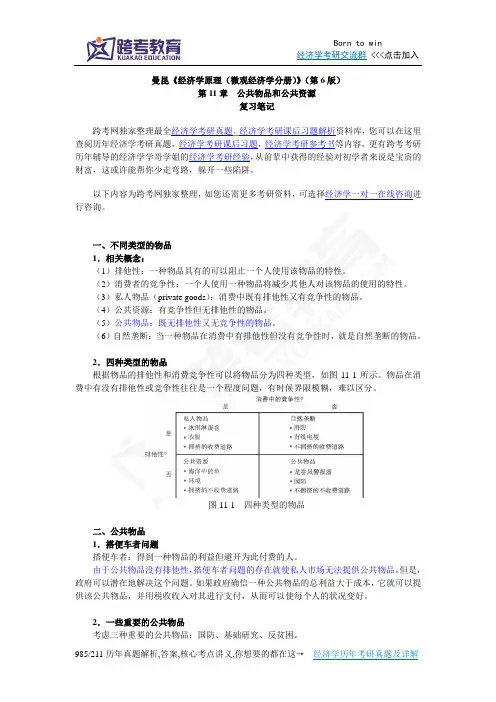
曼昆《经济学原理(微观经济学分册)》(第6版)第11章公共物品和公共资源复习笔记跨考网独家整理最全经济学考研真题,经济学考研课后习题解析资料库,您可以在这里查阅历年经济学考研真题,经济学考研课后习题,经济学考研参考书等内容,更有跨考考研历年辅导的经济学学哥学姐的经济学考研经验,从前辈中获得的经验对初学者来说是宝贵的财富,这或许能帮你少走弯路,躲开一些陷阱。
以下内容为跨考网独家整理,如您还需更多考研资料,可选择经济学一对一在线咨询进行咨询。
一、不同类型的物品1.相关概念:(1)排他性:一种物品具有的可以阻止一个人使用该物品的特性。
(2)消费者的竞争性:一个人使用一种物品将减少其他人对该物品的使用的特性。
(3)私人物品(private goods):消费中既有排他性又有竞争性的物品。
(4)公共资源:有竞争性但无排他性的物品。
(5)公共物品:既无排他性又无竞争性的物品。
(6)自然垄断:当一种物品在消费中有排他性但没有竞争性时,就是自然垄断的物品。
2.四种类型的物品根据物品的排他性和消费竞争性可以将物品分为四种类型,如图11-1所示。
物品在消费中有没有排他性或竞争性往往是一个程度问题,有时候界限模糊,难以区分。
图11-1 四种类型的物品二、公共物品1.搭便车者问题搭便车者:得到一种物品的利益但避开为此付费的人。
由于公共物品没有排他性,搭便车者问题的存在就使私人市场无法提供公共物品。
但是,政府可以潜在地解决这个问题。
如果政府确信一种公共物品的总利益大于成本,它就可以提供该公共物品,并用税收收入对其进行支付,从而可以使每个人的状况变好。
2.一些重要的公共物品考虑三种重要的公共物品:国防、基础研究、反贫困。
(1)国防国防既无排他性,也无竞争性。
国防是政府应该提供的公共物品。
(2)基础研究基础研究可以通过研究创造出知识。
知识可区分为一般性知识与特定知识:①特定技术知识可以申请专利,专利使发明者创造的知识具有了排他性,这将激励企业拿出资金用于新产品开发的研究中,以便获得专利并出售;②一般性知识是公共物品,既无排他性,也无竞争性,企业往往搭一般知识的便车,很少在上面投资。
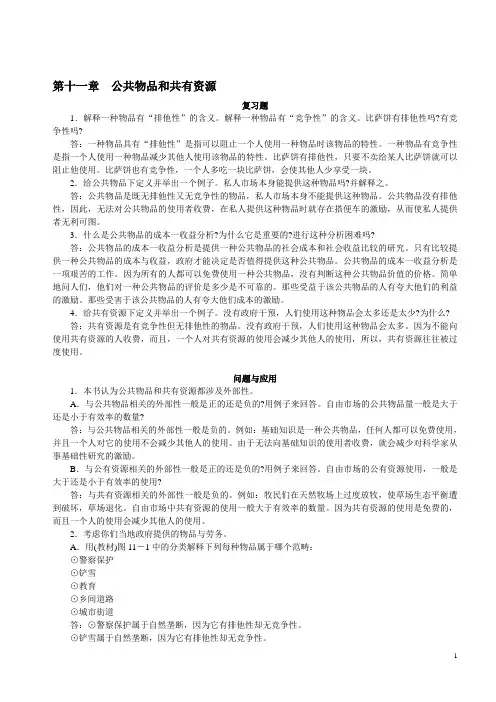
第十一章公共物品和共有资源复习题1.解释一种物品有“排他性”的含义。
解释一种物品有“竞争性”的含义。
比萨饼有排他性吗?有竞争性吗?答:一种物品具有“排他性”是指可以阻止一个人使用一种物品时该物品的特性。
一种物品有竞争性是指一个人使用一种物品减少其他人使用该物品的特性。
比萨饼有排他性,只要不卖给某人比萨饼就可以阻止他使用。
比萨饼也有竞争性,一个人多吃一块比萨饼,会使其他人少享受一块。
2.给公共物品下定义并举出一个例子。
私人市场本身能提供这种物品吗?并解释之。
答:公共物品是既无排他性又无竞争性的物品,私人市场本身不能提供这种物品。
公共物品没有排他性,因此,无法对公共物品的使用者收费,在私人提供这种物品时就存在搭便车的激励,从而使私人提供者无利可图。
3.什么是公共物品的成本一收益分析?为什么它是重要的?进行这种分析困难吗?答:公共物品的成本一收益分析是提供一种公共物品的社会成本和社会收益比较的研究。
只有比较提供一种公共物品的成本与收益,政府才能决定是否值得提供这种公共物品。
公共物品的成本一收益分析是一项艰苦的工作。
因为所有的人都可以免费使用一种公共物品,没有判断这种公共物品价值的价格。
简单地问人们,他们对一种公共物品的评价是多少是不可靠的。
那些受益于该公共物品的人有夸大他们的利益的激励。
那些受害于该公共物品的人有夸大他们成本的激励。
4.给共有资源下定义并举出一个例子。
没有政府干预,人们使用这种物品会太多还是太少?为什么?答:共有资源是有竞争性但无排他性的物品。
没有政府干预,人们使用这种物品会太多。
因为不能向使用共有资源的人收费,而且,一个人对共有资源的使用会减少其他人的使用,所以,共有资源往往被过度使用。
问题与应用1.本书认为公共物品和共有资源都涉及外部性。
A.与公共物品相关的外部性一般是正的还是负的?用例子来回答。
自由市场的公共物品量一般是大于还是小于有效率的数量?答:与公共物品相关的外部性一般是负的。
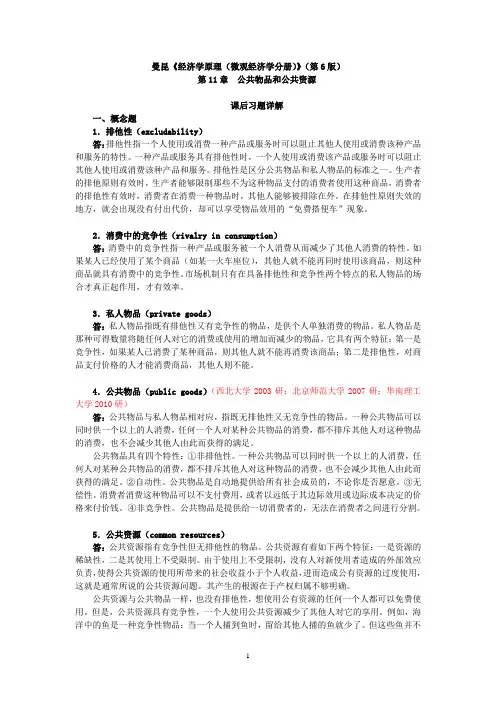
曼昆《经济学原理(微观经济学分册)》(第6版)第11章公共物品和公共资源课后习题详解一、概念题1.排他性(excludability)答:排他性指一个人使用或消费一种产品或服务时可以阻止其他人使用或消费该种产品和服务的特性。
一种产品或服务具有排他性时,一个人使用或消费该产品或服务时可以阻止其他人使用或消费该种产品和服务。
排他性是区分公共物品和私人物品的标准之一。
生产者的排他原则有效时,生产者能够限制那些不为这种物品支付的消费者使用这种商品,消费者的排他性有效时,消费者在消费一种物品时,其他人能够被排除在外。
在排他性原则失效的地方,就会出现没有付出代价,却可以享受物品效用的“免费搭便车”现象。
2.消费中的竞争性(rivalry in consumption)答:消费中的竞争性指一种产品或服务被一个人消费从而减少了其他人消费的特性。
如果某人已经使用了某个商品(如某一火车座位),其他人就不能再同时使用该商品,则这种商品就具有消费中的竞争性。
市场机制只有在具备排他性和竞争性两个特点的私人物品的场合才真正起作用,才有效率。
3.私人物品(private goods)答:私人物品指既有排他性又有竞争性的物品,是供个人单独消费的物品。
私人物品是那种可得数量将随任何人对它的消费或使用的增加而减少的物品,它具有两个特征:第一是竞争性,如果某人已消费了某种商品,则其他人就不能再消费该商品;第二是排他性,对商品支付价格的人才能消费商品,其他人则不能。
4.公共物品(public goods)(西北大学2003研;北京师范大学2007研;华南理工大学2010研)答:公共物品与私人物品相对应,指既无排他性又无竞争性的物品。
一种公共物品可以同时供一个以上的人消费,任何一个人对某种公共物品的消费,都不排斥其他人对这种物品的消费,也不会减少其他人由此而获得的满足。
公共物品具有四个特性:①非排他性。
一种公共物品可以同时供一个以上的人消费,任何人对某种公共物品的消费,都不排斥其他人对这种物品的消费,也不会减少其他人由此而获得的满足。
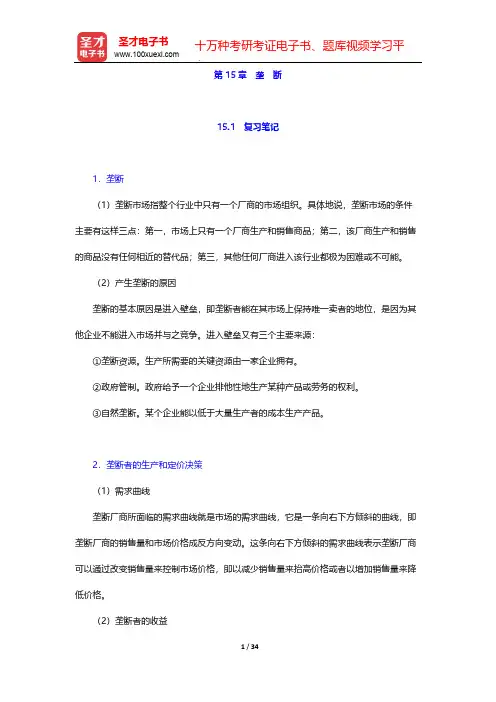
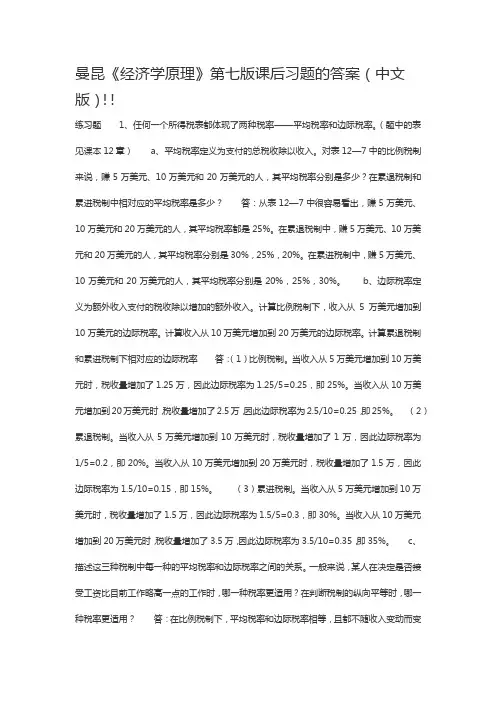
曼昆《经济学原理》第七版课后习题的答案(中文版)!!练习题1、任何一个所得税表都体现了两种税率——平均税率和边际税率。
(题中的表见课本12章)a、平均税率定义为支付的总税收除以收入。
对表12—7中的比例税制来说,赚5万美元、10万美元和20万美元的人,其平均税率分别是多少?在累退税制和累进税制中相对应的平均税率是多少?答:从表12—7中很容易看出,赚5万美元、10万美元和20万美元的人,其平均税率都是25%。
在累退税制中,赚5万美元、10万美元和20万美元的人,其平均税率分别是30%,25%,20%。
在累进税制中,赚5万美元、10万美元和20万美元的人,其平均税率分别是20%,25%,30%。
b、边际税率定义为额外收入支付的税收除以增加的额外收入。
计算比例税制下,收入从5万美元增加到10万美元的边际税率。
计算收入从10万美元增加到20万美元的边际税率。
计算累退税制和累进税制下相对应的边际税率答:(1)比例税制。
当收入从5万美元增加到10万美元时,税收量增加了1.25万,因此边际税率为1.25/5=0.25,即25%。
当收入从10万美元增加到20万美元时,税收量增加了2.5万,因此边际税率为2.5/10=0.25,即25%。
(2)累退税制。
当收入从5万美元增加到10万美元时,税收量增加了1万,因此边际税率为1/5=0.2,即20%。
当收入从10万美元增加到20万美元时,税收量增加了1.5万,因此边际税率为1.5/10=0.15,即15%。
(3)累进税制。
当收入从5万美元增加到10万美元时,税收量增加了1.5万,因此边际税率为1.5/5=0.3,即30%。
当收入从10万美元增加到20万美元时,税收量增加了3.5万,因此边际税率为3.5/10=0.35,即35%。
c、描述这三种税制中每一种的平均税率和边际税率之间的关系。
一般来说,某人在决定是否接受工资比目前工作略高一点的工作时,哪一种税率更适用?在判断税制的纵向平等时,哪一种税率更适用?答:在比例税制下,平均税率和边际税率相等,且都不随收入变动而变动。
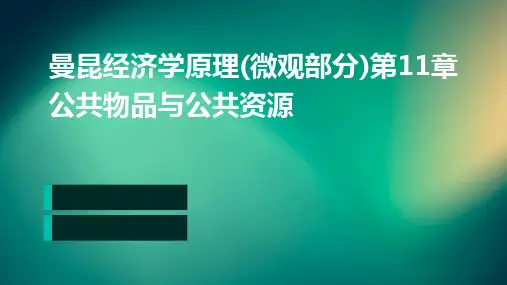
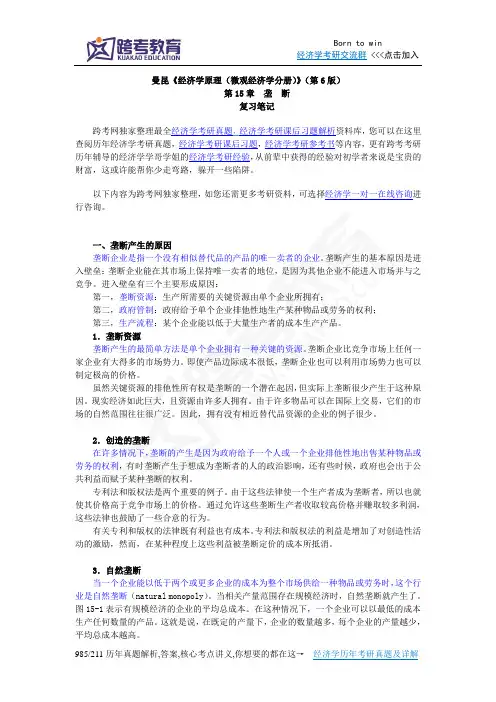
曼昆《经济学原理(微观经济学分册)》(第6版)第15章垄断复习笔记跨考网独家整理最全经济学考研真题,经济学考研课后习题解析资料库,您可以在这里查阅历年经济学考研真题,经济学考研课后习题,经济学考研参考书等内容,更有跨考考研历年辅导的经济学学哥学姐的经济学考研经验,从前辈中获得的经验对初学者来说是宝贵的财富,这或许能帮你少走弯路,躲开一些陷阱。
以下内容为跨考网独家整理,如您还需更多考研资料,可选择经济学一对一在线咨询进行咨询。
一、垄断产生的原因垄断企业是指一个没有相似替代品的产品的唯一卖者的企业。
垄断产生的基本原因是进入壁垒:垄断企业能在其市场上保持唯一卖者的地位,是因为其他企业不能进入市场并与之竞争。
进入壁垒有三个主要形成原因:第一,垄断资源:生产所需要的关键资源由单个企业所拥有;第二,政府管制:政府给予单个企业排他性地生产某种物品或劳务的权利;第三,生产流程:某个企业能以低于大量生产者的成本生产产品。
1.垄断资源垄断产生的最简单方法是单个企业拥有一种关键的资源。
垄断企业比竞争市场上任何一家企业有大得多的市场势力。
即使产品边际成本很低,垄断企业也可以利用市场势力也可以制定极高的价格。
虽然关键资源的排他性所有权是垄断的一个潜在起因,但实际上垄断很少产生于这种原因。
现实经济如此巨大,且资源由许多人拥有。
由于许多物品可以在国际上交易,它们的市场的自然范围往往很广泛。
因此,拥有没有相近替代品资源的企业的例子很少。
2.创造的垄断在许多情况下,垄断的产生是因为政府给予一个人或一个企业排他性地出售某种物品或劳务的权利,有时垄断产生于想成为垄断者的人的政治影响,还有些时候,政府也会出于公共利益而赋予某种垄断的权利。
专利法和版权法是两个重要的例子。
由于这些法律使一个生产者成为垄断者,所以也就使其价格高于竞争市场上的价格。
通过允许这些垄断生产者收取较高价格并赚取较多利润,这些法律也鼓励了一些合意的行为。
有关专利和版权的法律既有利益也有成本。

第十一章公共物品和共有资源复习题1.解释一种物品有“排他性”的含义。
解释一种物品有“竞争性”的含义。
比萨饼有排他性吗?有竞争性吗?答:一种物品具有“排他性”是指可以阻止一个人使用一种物品时该物品的特性。
一种物品有竞争性是指一个人使用一种物品减少其他人使用该物品的特性。
比萨饼有排他性,只要不卖给某人比萨饼就可以阻止他使用。
比萨饼也有竞争性,一个人多吃一块比萨饼,会使其他人少享受一块。
2.给公共物品下定义并举出一个例子。
私人市场本身能提供这种物品吗?并解释之。
答:公共物品是既无排他性又无竞争性的物品,私人市场本身不能提供这种物品。
公共物品没有排他性,因此,无法对公共物品的使用者收费,在私人提供这种物品时就存在搭便车的激励,从而使私人提供者无利可图。
3.什么是公共物品的成本一收益分析?为什么它是重要的?进行这种分析困难吗?答:公共物品的成本一收益分析是提供一种公共物品的社会成本和社会收益比较的研究。
只有比较提供一种公共物品的成本与收益,政府才能决定是否值得提供这种公共物品。
公共物品的成本一收益分析是一项艰苦的工作。
因为所有的人都可以免费使用一种公共物品,没有判断这种公共物品价值的价格。
简单地问人们,他们对一种公共物品的评价是多少是不可靠的。
那些受益于该公共物品的人有夸大他们的利益的激励。
那些受害于该公共物品的人有夸大他们成本的激励。
4.给共有资源下定义并举出一个例子。
没有政府干预,人们使用这种物品会太多还是太少?为什么?答:共有资源是有竞争性但无排他性的物品。
没有政府干预,人们使用这种物品会太多。
因为不能向使用共有资源的人收费,而且,一个人对共有资源的使用会减少其他人的使用,所以,共有资源往往被过度使用。
问题与应用1.本书认为公共物品和共有资源都涉及外部性。
A.与公共物品相关的外部性一般是正的还是负的?用例子来回答。
自由市场的公共物品量一般是大于还是小于有效率的数量?答:与公共物品相关的外部性一般是负的。
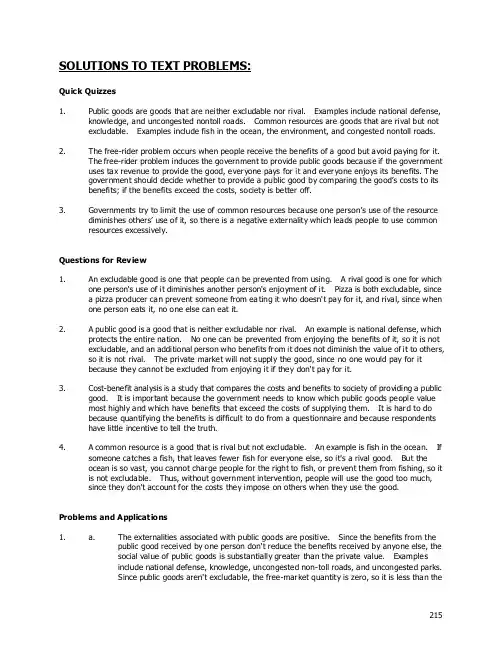
SOLUTIONS TO TEXT PROBLEMS:Quick Quizzes1. Public goods are goods that are neither excludable nor rival. Examples include national defense,knowledge, and uncongested nontoll roads. Common resources are goods that are rival but not excludable. Examples include fish in the ocean, the environment, and congested nontoll roads. 2. The free-rider problem occurs when people receive the benefits of a good but avoid paying for it.The free-rider problem induces the government to provide public goods because if the government uses tax revenue to provide the good, everyone pays for it and everyone enjoys its benefits. The government should decide whether to provide a public good by comparing the good’s costs to its benefits; if the benefits exceed the costs, society is better off.3. Governments try to limit the use of common resources because one person’s use of the resourcediminishes others’ use of it, so there is a negative externality which leads people to use common resources excessively.Questions for Review1. An excludable good is one that people can be prevented from using. A rival good is one for whichone person's use of it diminishes another person's enjoyment of it. Pizza is both excludable, sincea pizza producer can prevent someone from ea ting it who doesn't pay for it, and rival, since whenone person eats it, no one else can eat it.2. A public good is a good that is neither excludable nor rival. An example is national defense, whichprotects the entire nation. No one can be prevented from enjoying the benefits of it, so it is not excludable, and an additional person who benefits from it does not diminish the value of it to others, so it is not rival. The private market will not supply the good, since no one would pay for itbecause they cannot be excluded from enjoying it if they don't pay for it.3. Cost-benefit analysis is a study that compares the costs and benefits to society of providing a publicgood. It is important because the government needs to know which public goods people value most highly and which have benefits that exceed the costs of supplying them. It is hard to dobecause quantifying the benefits is difficult to do from a questionnaire and because respondents have little incentive to tell the truth.4. A common resource is a good that is rival but not excludable. An example is fish in the ocean. Ifsomeone catches a fish, that leaves fewer fish for everyone else, so it's a rival good. But theocean is so vast, you cannot charge people for the right to fish, or prevent them from fishing, so it is not excludable. Thus, without government intervention, people will use the good too much,since they don't account for the costs they impose on others when they use the good.Problems and Applicat ions1. a. The externalities associated with public goods are positive. Since the benefits from thepublic good received by one person don't reduce the benefits received by anyone else, thesocial value of public goods is substantially greater than the private value. Examplesinclude national defense, knowledge, uncongested non-toll roads, and uncongested parks.Since public goods aren't excludable, the free-market quantity is zero, so it is less than the215efficient quantity.b. The externalities associated with common resources are generally negative. Sincecommon resources are rival but not excludable (so not priced) the use of the commonresources by one person reduces the amount available for others. Since commonresources are not priced, people tend to overuse them their private cost of using theresources is less than the social cost. Examples include fish in the ocean, theenvironment, congested non-toll roads, the Town Commons, and congested parks.2. a. (1) Police protection is a natural monopoly, since it is excludable (the police may ignoresome neighborhoods) and not rival (unless the police force is overworked, they're availablewhenever a crime arises). You could make an argument that police protection is rival, ifthe police are too busy to respond to all crimes, so that one person's use of the policereduces the amount available for others; in that case, police protection is a private good.(2) Snow plowing is most likely a common resource. Once a street is plowed, it isn'texcludable. But it is rival, especially right after a big snowfall, since plowing one streetmeans not plowing another street.(3) Education is a private good (with a positive externality). It is excludable, sincesomeone who doesn't pay can be prevented from taking classes. It is rival, since thepresence of an additional student in a class reduces the benefits to others.(4) Rural roads are public goods. They aren't excludable and they aren't rival sincethey're uncongested.(5) City streets are common resources when congested. They aren't excludable, sinceanyone can drive on them. But they are rival, since congestion means every additionaldriver slows down the progress of other drivers. When they aren't congested, city streetsare public goods, since they're no longer rival.b. The government may provide goods that aren't public goods, such as education, becauseof the externalities associated with them.3. a. Charlie is a free rider.b. The government could solve the problem by sponsoring the show and paying for it with taxrevenue collected from everyone.c. The private market could also solve the problem by making people watch commercials thatare incorporated into the program. The existence of cable TV makes the good excludable,so it would no longer be a public good.4. a. Since knowledge is a public good, the benefits of basic scientific research are available tomany people. The private firm doesn't take this into account when choosing how muchresearch to undertake; it only takes into account what it will earn.b. The United States has tried to give private firms incentives to provide basic research bysubsidizing it through organizations like the National Institute of Health and the NationalScience Foundation.c. If it's basic research that adds to knowledge, it isn't excludable at all, unless people in othercountries can be prevented somehow from sharing that knowledge. So perhaps U.S.firms get a slight advantage because they hear about technological advances first, butknowledge tends to diffuse rapidly.5. When a person litters along a highway, others bear the negative externality, so the private costsare low. Littering in your own yard imposes costs on you, so it has a higher private cost and is thus rare.6. When the system is congested, each additional rider imposes costs on other riders. For example,when all seats are taken, some people must stand. Or if there isn't any room to stand, somepeople must wait for a train that isn't as crowded. Increasing the fare during rush hourinternalizes this externality.7. On privately owned land, the amount of logging is likely to be efficient. Loggers have incentives todo the right amount of logging, since they care that the trees replenish themselves and the forest can be logged in the future. Publicly owned land, however, is a common resource, and is likely to be overlogged, since loggers won't worry about the future value of the land.Since public lands tend to be overlogged, the government can improve things by restricting thequantity of logging to its efficient level. Selling permits to log, or taxing logging, could be used to reach the appropriate quantity by internalizing the externality. Such restrictions are unnecessary on privately owned lands, since there is no externality.8. a. Overfishing is rational for fishermen since they're using a common resource. They don'tbear the costs of reducing the number of fish available to others, so it's rational for them tooverfish. The free-market quantity of fishing exceeds the efficient amount.b. A solution to the problem could come from regulating the amount of fishing, taxing fishingto internalize the externality, or auctioning off fishing permits. But these solutionswouldn't be easy to implement, since many nations have access to ocea ns, so internationalcooperation would be necessary, and enforcement would be difficult, because the sea is solarge that it is hard to police.c. By giving property rights to countries, the scope of the problem is reduced, since eachcountry has a greater incentive to find a solution. Each country can impose a tax or issuepermits, and monitor a smaller area for compliance.d. Since government agencies (like the Coast Guard in the United States) protect fishermenand rescue them when they need help, the fishermen aren't bearing the full costs of theirfishing. Thus they fish more than they should.e. The statement, "Only when fishermen believe they are assured a long-term and exclusiveright to a fishery are they likely to manage it in the same far-sighted way as good farmersmanage they land," is sensible. If fishermen owned the fishery, they would be sure not tooverfish, because they would bear the costs of overfishing. This is a case in whichproperty rights help prevent the overuse of a common resource.f. Alternatives include regulating the amount of fishing, taxing fishermen, auctioning offfishing permits, or taxing fish sold in stores. All would tend to reduce the amount offishing from the free-market amount toward the efficient amount.9. The private market provides information about the quality or function of goods and services inseveral different ways. First, producers advertise, providing people information about the product and its quality. Second, private firms provide information to consumers with independent reportson quality; an example is the magazine Consumer Reports. The government plays a role as well, by regulating advertising, thus preventing firms from exaggerating claims about their products,regulating certain goods like gasoline and food to be sure they are measured properly and provided without disease, and not allowing dangerous products on the market.10. To be a public good, a good must be neither rival nor excludable. When the Internet isn’tcongested, it is n ot rival, since one person’s use of it does not affect anyone else. However, at times traffic on the Internet is so great that everything slows down at such times, the Internet is rival. Is the Internet excludable? Since anyone operating a Web site can charge a customer for visiting the site by requiring a password, the Internet is excludable. Thus the Internet is notstrictly a public good. Since the Internet is usually not rival, it is more like a natural monopolythan a public good. However, since most people’s Web sites contain information and exclude no one, the majority of the Internet is a public good (when it is not congested).11. Recognizing that there are opportunity costs that are relevant for cost-benefit analysis is the key toanswering this question. A richer community can afford to place a higher value on life and safety.So the richer community is willing to pay more for a traffic light, and that should be considered in cost-benefit analysis.。
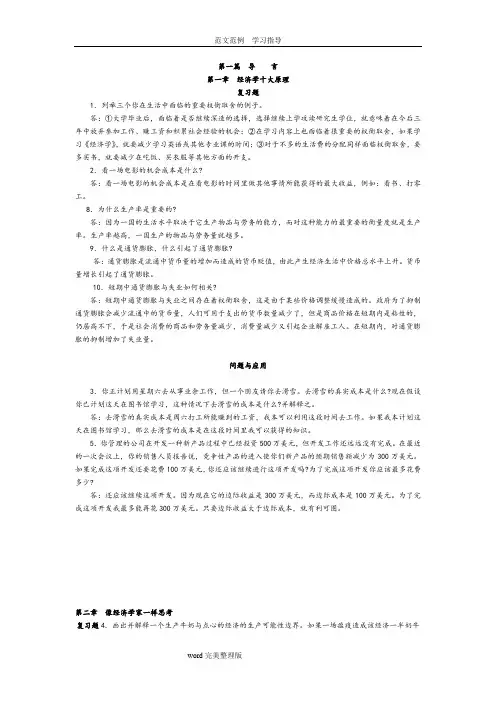
第一篇导言第一章经济学十大原理复习题1.列举三个你在生活中面临的重要权衡取舍的例子。
答:①大学毕业后,面临着是否继续深造的选择,选择继续上学攻读研究生学位,就意味着在今后三年中放弃参加工作、赚工资和积累社会经验的机会;②在学习内容上也面临着很重要的权衡取舍,如果学习《经济学》,就要减少学习英语或其他专业课的时间;③对于不多的生活费的分配同样面临权衡取舍,要多买书,就要减少在吃饭、买衣服等其他方面的开支。
2.看一场电影的机会成本是什么?答:看一场电影的机会成本是在看电影的时间里做其他事情所能获得的最大收益,例如:看书、打零工。
8.为什么生产率是重要的?答:因为一国的生活水平取决于它生产物品与劳务的能力,而对这种能力的最重要的衡量度就是生产率。
生产率越高,一国生产的物品与劳务量就越多。
9.什么是通货膨胀,什么引起了通货膨胀?答:通货膨胀是流通中货币量的增加而造成的货币贬值,由此产生经济生活中价格总水平上升。
货币量增长引起了通货膨胀。
10.短期中通货膨胀与失业如何相关?答:短期中通货膨胀与失业之间存在着权衡取舍,这是由于某些价格调整缓慢造成的。
政府为了抑制通货膨胀会减少流通中的货币量,人们可用于支出的货币数量减少了,但是商品价格在短期内是粘性的,仍居高不下,于是社会消费的商品和劳务量减少,消费量减少又引起企业解雇工人。
在短期内,对通货膨胀的抑制增加了失业量。
问题与应用3.你正计划用星期六去从事业余工作,但一个朋友请你去滑雪。
去滑雪的真实成本是什么?现在假设你已计划这天在图书馆学习,这种情况下去滑雪的成本是什么?并解释之。
答:去滑雪的真实成本是周六打工所能赚到的工资,我本可以利用这段时间去工作。
如果我本计划这天在图书馆学习,那么去滑雪的成本是在这段时间里我可以获得的知识。
5.你管理的公司在开发一种新产品过程中已经投资500万美元,但开发工作还远远没有完成。
在最近的一次会议上,你的销售人员报告说,竞争性产品的进入使你们新产品的预期销售额减少为300万美元。
Chapter 15Problems and Applications1. The following table shows revenue, costs, and profits, where quantities are inthousands, and total revenue, total cost, and profit are in millions of dollars:a. A profit-maximizing publisher would choose a quantity of 400,000 at a price of$60 or a quantity of 500,000 at a price of $50; both combinations would leadto profits of $18 million.b. Marginal revenue is always less than price. Price falls when quantity risesbecause the demand curve slopes downward, but marginal revenue falls evenmore than price because the firm loses revenue on all the units of the goodsold when it lowers the price.c. Figure 15-2 shows the marginal-revenue, marginal-cost, and demand curves.The marginal-revenue and marginal-cost curves cross between quantities of400,000 and 500,000. This signifies that the firm maximizes profits in thatregion.Figure 15-2d. The area of deadweight loss is marked “DWL” in the figure. Deadweight lossmeans that the total surplus in the economy is less than it would be if themarket were competitive, since the monopolist produces less than the socially efficient level of output.e. If the author were paid $3 million instead of $2 million, the publisher wouldn’tchange the price, since there would be no change in marginal cost or marginal revenue.f. To maximize economic efficiency, the publisher would set the price at $10 perbook, since that’s the marginal cost of the book. At that price, the publisherwould have negative profits equal to the amount paid to the author.Figure 15-32. Figure 15-3 illustrates a natural monopolist setting price, P ATC, equal to average totalcost. The equilibrium quantity is Q ATC. Marginal cost pricing would yield the price P MC and quantity Q MC. Since for quantities between Q ATC and Q MC the benefit to consumers (measured by the demand curve) exceeds the cost of production (measured by themarginal cost curve), the deadweight loss from setting price equal to average total cost is the triangular area shown in the figure.3. Mail delivery has an always-declining average-total-cost curve, since there are largefixed costs for equipment. The marginal cost of delivering a letter is very small.However, the costs are higher in isolated rural areas than they are in densely populated urban areas, since transportation costs differ. Over time, increased automation hasreduced marginal cost and increased fixed costs, so the average-total-cost curve has become steeper at small quantities and flatter at high quantities.4. If the price of tap water rises, the demand for bottled water increases. This is shownin Figure 15-4 as a shift to the right in the demand curve from D1 to D2. Thecorresponding marginal-revenue curves are MR1 and MR2. The profit-maximizinglevel of output is where marginal cost equals marginal revenue. Prior to the increase in the price of tap water, the profit-maximizing level of output is Q1; after the priceincrease, it rises to Q2. The profit-maximizing price is shown on the demand curve:it is P1 before the price of tap water rises, and it rises to P2 after. Average cost is AC1 before the price of tap water rises and AC2 after. Profit increases from (P1 - AC1) x Q1 to (P2 - AC2) x Q2.Figure 15-45. a. Figure 15-5 illustrates the market for groceries when there are manycompeting supermarkets with constant marginal cost. Output is Q C, price isP C, consumer surplus is area A, producer surplus is zero, and total surplus isarea A.b. If the supermarkets merge, Figure 15-6 illustrates the new situation.Quantity declines from Q C to Q M and price rises to P M. Area A in Figure 15-5 is equal to area B+C+D+E+F in Figure 15-6. Consumer surplus is now areaB+C, producer surplus is area D+E, and total surplus is area B+C+D+E.Consumers transfer the amount of area D+E to producers and the deadweight loss is area F.Figure 15-5Figure 15-66. a. The following table shows total revenue and marginal revenue for each priceand quantity sold:b. Profits are maximized at a price of $16 and quantity of 50,000. At that point,profit is $550,000.c. As Johnny's agent, you should recommend that he demand $550,000 fromthem, so he gets all the profit instead of the record company.7. IBM's monopoly power will be constrained to the extent that people can substituteother computers for mainframes. So the government might have looked at thedemand curve facing IBM, or the divergence between IBM's price and marginal cost, to get some idea of how severe the monopoly problem was.8. a. The following table shows revenue and marginal revenue for the bridge:The profit-maximizing price would be where revenue is maximized, which willoccur where marginal revenue equals zero, since marginal cost equals zero.This occurs at a price of $4 and quantity of 400. The efficient level of outputis 800, since that's where price equals marginal cost equals zero. Theprofit-maximizing quantity is lower than the efficient quantity because the firmis a monopolist.b. The company shouldn't build the bridge because its profits are negative. Themost revenue it can earn is $1,600,000 and the cost is $2,000,000, so it wouldlose $400,000.Figure 15-7c. If the government were to build the bridge, it should set price equal tomarginal cost to be efficient. But marginal cost is zero, so the governmentshouldn't charge people to use the bridge.d. Yes, the government should build the bridge, because it would increasesociety's total surplus. As shown in Figure 15-7, total surplus has area 1/2 x 8x 800,000 = $3,200,000, which exceeds the cost of building the bridge.9. a. Figure 15-8 illustrates the drug company's situation. They'll produce quantityQ1 at price P1. Profits are equal to (P1 - AC1) x Q1.Figure 15-8b. The tax on the drug increases both marginal cost and average cost by theamount of the tax. As a result, as shown in Figure 15-9, quantity is reduced to Q2, price rises to P2, and average cost plus tax rises to AC2.Figure 15-9c. The tax definitely reduces profits. After all, the firm could have producedquantity Q2 at price P2 before the tax was imposed, but it didn't maximizeprofits. So the firm's revenue less costs are lower after the tax is imposed; inaddition, the firm must pay the tax.d. A tax of $10,000 regardless of how many bottles of the drug are producedwould result in the quantity produced at Q1 and the price at P1 in Figure 15-8because such a tax doesn't affect marginal cost or marginal revenue. It does,however, raise average cost; in fact, profits decline by exactly $10,000.10. Larry wants to sell as many drinks as possible without losing money, so he wants to setquantity where price (demand) equals average cost, which occurs at quantity Q L and price P L in Figure 15-10. Curly wants to bring in as much revenue as possible, which occurs where marginal revenue equals zero, at quantity Q C and price P C. Moe wants to maximize profits, which occurs where marginal cost equals marginal revenue, atquantity Q M and price P M.Figure 15-1011. a. Long-distance phone service was originally a natural monopoly becauseinstallation of phone lines across the country meant that one firm's costs weremuch lower than if two or more firms did the same thing.b. With communications satellites, the cost is no different if one firm suppliesthem or if many firms do so. So the industry evolved from a naturalmonopoly to a competitive market.c. It is efficient to have competition in long-distance phone service and regulatedmonopolies in local phone service because local phone service remains anatural monopoly (being based on land lines) while long-distance service is acompetitive market (being based on satellites).12. a. The patent gives the company a monopoly, as shown in Figure 15-11. At aquantity of Q M and price of P M, consumer surplus is area A+B, producer surplusis area C+D, and total surplus is area A+B+C+D.Figure 15-11b. If the firm can perfectly price discriminate, it will produce quantity Q C andextract all the consumer surplus. Consumer surplus is zero and producersurplus is A+B+C+D+E, as is total surplus. Deadweight loss is reduced fromarea E to zero. There's a transfer of surplus from consumers to producers ofarea A+B.13. A monopolist always produces a quantity at which the demand curve is elastic. If thefirm produced a quantity for which the demand curve were inelastic, then if the firmraised its price, quantity would fall by a smaller percentage than the rise in price, sorevenue would increase. Since costs would decrease at a lower quantity, the firmwould have higher revenue and lower costs, so profit would be higher. Thus the firm should keep raising its price until profits are maximized, which must happen on anelastic portion of the demand curve.Another way to see this is to note that on an inelastic portion of the demand curve,marginal revenue is negative. Increasing quantity requires a greater percentagereduction in price, so revenue declines. Since a firm maximizes profit where marginal cost equals marginal revenue, and marginal cost is never negative, theprofit-maximizing quantity can never occur where marginal revenue is negative, so can never be on an inelastic portion of the demand curve.14. The government could create monopoly power for the Big Three U.S. automakers byrestricting imported cars. Then the Big Three would face much less competition and could drive their prices up substantially.15. Though Whitney Houston has a monopoly on her own singing, there are many othersingers in the market. If Houston were to raise her price too much, people wouldsubstitute to other singers. So there's no need for the government to regulate theprice of her concerts.16. a. Figure 15-12 shows the cost, demand, and marginal-revenue curves for themonopolist. Without price discrimination, the monopolist would charge priceP M and produce quantity Q M.Figure 15-12b. The monopolist's profit consists of the two areas labeled X, consumer surplusis the two areas labeled Y, and the deadweight loss is the area labeled Z.c. If the monopolist can perfectly price discriminate, it produces quantity Q C, andhas profit equal to X+Y+Z.d. The monopolist's profit increases from X to X+Y+Z, an increase in the amountY+Z. The change in total surplus is area Z. The rise in monopolist's profit isgreater than the change in total surplus, since monopolist's profit increasesboth by the amount of deadweight loss (Z) and by the transfer fromconsumers to the monopolist (Y).e. A monopolist would pay the fixed cost that allows it to discriminate as long asY+Z (the increase in profits) exceeds C (the fixed cost).f. A benevolent social planner who cared about maximizing total surplus wouldwant the monopolist to price discriminate only if Z (the deadweight loss frommonopoly) exceeded C (the fixed cost) since total surplus rises by Z - C.g. The monopolist has a greater incentive to price discriminate (it will do so ifY+Z>C) than the social planner would allow (she would allow it only if Z>C).Thus if Z<C but Y+Z>C, the monopolist will price discriminate even though it's not in society's interest.。
曼昆《经济学原理(微观经济学分册)》(第6版)第11章公共物品和公共资源课后习题详解跨考网独家整理最全经济学考研真题,经济学考研课后习题解析资料库,您可以在这里查阅历年经济学考研真题,经济学考研课后习题,经济学考研参考书等内容,更有跨考考研历年辅导的经济学学哥学姐的经济学考研经验,从前辈中获得的经验对初学者来说是宝贵的财富,这或许能帮你少走弯路,躲开一些陷阱。
以下内容为跨考网独家整理,如您还需更多考研资料,可选择经济学一对一在线咨询进行咨询。
一、概念题1.排他性(excludability)答:排他性指一个人使用或消费一种产品或服务时可以阻止其他人使用或消费该种产品和服务的特性。
一种产品或服务具有排他性时,一个人使用或消费该产品或服务时可以阻止其他人使用或消费该种产品和服务。
排他性是区分公共物品和私人物品的标准之一。
生产者的排他原则有效时,生产者能够限制那些不为这种物品支付的消费者使用这种商品,消费者的排他性有效时,消费者在消费一种物品时,其他人能够被排除在外。
在排他性原则失效的地方,就会出现没有付出代价,却可以享受物品效用的“免费搭便车”现象。
2.消费中的竞争性(rivalry in consumption)答:消费中的竞争性指一种产品或服务被一个人消费从而减少了其他人消费的特性。
如果某人已经使用了某个商品(如某一火车座位),其他人就不能再同时使用该商品,则这种商品就具有消费中的竞争性。
市场机制只有在具备排他性和竞争性两个特点的私人物品的场合才真正起作用,才有效率。
3.私人物品(private goods)答:私人物品指既有排他性又有竞争性的物品,是供个人单独消费的物品。
私人物品是那种可得数量将随任何人对它的消费或使用的增加而减少的物品,它具有两个特征:第一是竞争性,如果某人已消费了某种商品,则其他人就不能再消费该商品;第二是排他性,对商品支付价格的人才能消费商品,其他人则不能。
4.公共物品(public goods)(西北大学2003研;北京师范大学2007研;华南理工大学2010研)答:公共物品与私人物品相对应,指既无排他性又无竞争性的物品。
目 录第1篇 导 言第1章 经济学十大原理第2章 像经济学家一样思考第3章 相互依存性与贸易的好处第2篇 市场如何运行第4章 供给与需求的市场力量第5章 弹性及其应用第6章 供给、需求与政府政策第3篇 市场和福利第7章 消费者、生产者与市场效率第8章 应用:赋税的代价第9章 应用:国际贸易第4篇 公共部门经济学第10章 外部性第11章 公共物品和公共资源第12章 税制的设计第5篇 企业行为与产业组织第13章 生产成本第14章 竞争市场上的企业第15章 垄 断第16章 垄断竞争第17章 寡 头第6篇 劳动市场经济学第18章 生产要素市场第19章 收入与歧视第20章 收入不平等与贫困第7篇 深入研究的论题第21章 消费者选择理论第22章 微观经济学前沿第1篇 导 言第1章 经济学十大原理一、概念题1.稀缺性(scarcity)答:经济学研究的问题和经济物品都是以稀缺性为前提的。
稀缺性指在给定的时间内,相对于人的需求而言,经济资源的供给总是不足的,也就是资源的有用性与有限性。
人类消费各种物品的欲望是无限的,满足这种欲望的物品,有的可以不付出任何代价而随意取得,称之为自由物品,如阳光和空气;但绝大多数物品是不能自由取用的,因为世界上的资源(包括物质资源和人力资源)是有限的,这种有限的、为获取它必须付出某种代价的物品,称为“经济物品”。
正因为稀缺性的客观存在,地球上就存在着资源的有限性和人类的欲望与需求的无限性之间的矛盾。
经济学的一个重要研究任务就是:“研究人们如何进行抉择,以便使用稀缺的或有限的生产性资源(土地、劳动、资本品如机器、技术知识)来生产各种商品,并把它们分配给不同的社会成员进行消费。
”也就是从经济学角度来研究使用有限的资源来生产什么、如何生产和为谁生产的问题。
2.经济学(economics)答:经济学是研究如何将稀缺的资源有效地配置给相互竞争的用途,以使人类的欲望得到最大限度满足的科学。
时下经常见诸国内报刊文献的“现代西方经济学”一词,大多也都在这个意义上使用。
第一章经济学十大原理一、为每个关键术语选择一个定义关键术语定义--------------稀缺性1、在社会成员中平等地分配利益的特征--------------经济学2、市场不能有效的配置资源的状况--------------效率3、有限的资源和无限的欲望--------------平等4、一个工人一小时所生产的物品与劳务量--------------理性5、市场上只有一个买者的情况--------------机会成本6、利己的市场参与者可以不知不觉的使整体社会福利最大化的原理--------------边际变动7、社会从其稀缺资源中得到最多东西的特性--------------激励8、社会和企业在市场上的相互交易决定资源配置的经济--------------市场经济9、经济活动的波动--------------产权10、当一个人的行为对旁观者有影响时的情况--------------“看不见的手”11、物价总水平的上升--------------市场失灵12、对现行计划的增量调整--------------外部性13、研究社会如何管理其稀缺资源--------------市场势力14、得到某种东西所放弃的东西--------------垄断15、一个人或一群人不适当的影响市场价格的能力--------------生产率16、某种引起人行动的东西--------------通货膨胀17、一个人拥有并使用稀缺资源的能力--------------经济周期18、为了达到目标而尽可能系统性的做到最好二、判断正误--------------1、当政府用税收和福利再分配收入时,经济变得更有效率。
-------------2、当经济学家说“天下没有免费的午餐”时,他们是指所有经济决策都涉及权衡取舍。
-------------3、亚当斯密的“看不见的手”的概念描述了公司经营如何像一只“看不见的手”伸到消费者的钱包中。
第十一章公共物品和共有资源复习题1.解释一种物品有“排他性”的含义。
解释一种物品有“竞争性”的含义。
比萨饼有排他性吗?有竞争性吗?答:一种物品具有“排他性”是指可以阻止一个人使用一种物品时该物品的特性。
一种物品有竞争性是指一个人使用一种物品减少其他人使用该物品的特性。
比萨饼有排他性,只要不卖给某人比萨饼就可以阻止他使用。
比萨饼也有竞争性,一个人多吃一块比萨饼,会使其他人少享受一块。
2.给公共物品下定义并举出一个例子。
私人市场本身能提供这种物品吗?并解释之。
答:公共物品是既无排他性又无竞争性的物品,私人市场本身不能提供这种物品。
公共物品没有排他性,因此,无法对公共物品的使用者收费,在私人提供这种物品时就存在搭便车的激励,从而使私人提供者无利可图。
3.什么是公共物品的成本一收益分析?为什么它是重要的?进行这种分析困难吗?答:公共物品的成本一收益分析是提供一种公共物品的社会成本和社会收益比较的研究。
只有比较提供一种公共物品的成本与收益,政府才能决定是否值得提供这种公共物品。
公共物品的成本一收益分析是一项艰苦的工作。
因为所有的人都可以免费使用一种公共物品,没有判断这种公共物品价值的价格。
简单地问人们,他们对一种公共物品的评价是多少是不可靠的。
那些受益于该公共物品的人有夸大他们的利益的激励。
那些受害于该公共物品的人有夸大他们成本的激励。
4.给共有资源下定义并举出一个例子。
没有政府干预,人们使用这种物品会太多还是太少?为什么?答:共有资源是有竞争性但无排他性的物品。
没有政府干预,人们使用这种物品会太多。
因为不能向使用共有资源的人收费,而且,一个人对共有资源的使用会减少其他人的使用,所以,共有资源往往被过度使用。
问题与应用1.本书认为公共物品和共有资源都涉及外部性。
A.与公共物品相关的外部性一般是正的还是负的?用例子来回答。
自由市场的公共物品量一般是大于还是小于有效率的数量?答:与公共物品相关的外部性一般是负的。
例如:基础知识是一种公共物品,任何人都可以免费使用,并且一个人对它的使用不会减少其他人的使用。
由于无法向基础知识的使用者收费,就会减少对科学家从事基础性研究的激励。
B.与公有资源相关的外部性一般是正的还是负的?用例子来回答。
自由市场的公有资源使用,一般是大于还是小于有效率的使用?答:与共有资源相关的外部性一般是负的。
例如:牧民们在天然牧场上过度放牧,使草场生态平衡遭到破坏,草场退化。
自由市场中共有资源的使用一般大于有效率的数量。
因为共有资源的使用是免费的,而且一个人的使用会减少其他人的使用。
2.考虑你们当地政府提供的物品与劳务。
A.用(教材)图11-1中的分类解释下列每种物品属于哪个范畴:⊙警察保护⊙铲雪⊙教育⊙乡间道路⊙城市街道答:⊙警察保护属于自然垄断,因为它有排他性却无竞争性。
⊙铲雪属于自然垄断,因为它有排他性却无竞争性。
⊙教育,尤其是义务教育属于共有资源,因为它无排他性却有竞争性。
⊙乡间道路属于公共物品,因为它即无排他性又无竞争性。
⊙城市道路属于共有资源,因为它无排他性却有竞争性。
B.为什么你认为政府提供了不是公共物品的东西?答:即使政府提供的物品和劳务不收费,也不能避免该种物品或劳务有竞争性。
例如城市道路,它一般是拥挤的,人们使用它不收费,但多一个人行走,就会使他人觉得更拥挤。
无排他性却有竞争性的物品是共有资源,不是公共物品。
而且,政府提供的某些物品或劳务可以不通过收费产生排他性。
如警察保护,只要警察对某个犯罪行为袖手旁观,就会使被害人不能享受这种劳务。
这种有排他性却无竞争性的物品不是公共物品,而是自然垄断。
3.查理喜欢看本地公共电视台的电视节目,但在电视台筹集运营资金的时候,他从不给一点钱支持电视台。
A.经济学家把查理称为什么名称?答:经济学家把查理称作“搭便车者”。
B.政府如何能解决像查理这样的人引起的问题?答:政府通过向查理们征税获取资金,用这些钱对电视台进行补贴。
C.你认为私人市场有解决这个问题的方法吗?如何把有线电视台的存在改变为公共电视台?答:我认为私人市场有解决这个问题的方法。
可以把这个公共电视台变成有线电视台,只有缴费的人才能开通该有线电视。
如果把有线电视台的存在改变为公共电视台,只有通过政府向当地居民征税,再用税收收入来补贴公共电视台。
4.本书认为私人企业没有从事基础研究的有效率数量。
A.解释为什么是这样。
在你的回答中,把基础研究划人(教材)图11-1所示的类型中的某一类。
答:基础研究的成果不具有产权,任何人都可以免费使用,而且不具有竞争性。
它是一种公共物品,私人企业没有提供的激励。
B.美国政府对这个问题的反应是采取了哪一类政策?答:美国政府采取了由国家出资进行基础科学研究的政策。
政府用税收收入开设研究机构,或对私人研究机构进行资助,开展基础科学研究。
C.人们往往认为,这种政策提高了美国生产者相对于外国企业的技术能力。
这种观点与你在(A)中对基础研究的分类一致吗?(提示:排他性是否能适用于一种公共物品的某些潜在受益者而不适用于其他人?)答:这种观点与基础科学研究是公共物品的分类不矛盾。
因为任何事物都是相对的,公共物品的排他性也是如此。
基础科学研究成果在美国国内使用是没有排他性的。
但在国际领域,美国政府为了保护自己的研究成果不被对手国家使用,可以采取一系列相关措施,使某项研究成果对外保密,使美国生产者的生产能力相对高于外国同类企业。
5.为什么在大多数高速公路边都有垃圾,而在人们的院子里却很少呢?答:因为高速公路旁边的环境是共有资源,共有资源没有排他性,人们会随意使用。
同时,共有资源有竞争性,人们在使用时会产生负外部性,但没有人考虑负外部性,因此大多数高速公路旁都有垃圾。
而人们院子里的环境是私人物品,有排他性和竞争性。
人们在使用时要比较使用的成本和收益,因此自家院里的垃圾就很少。
6.华盛顿特区地铁系统在上下班高峰期的收费高于一天中的其他时间。
为什么应该这样做?答:因为地铁系统中的拥挤是一种负外部性。
上下班高峰期比平时拥挤得多,这时的外部性远远大于平时,解决这种外部性的有效方法是在上下班高峰期高收费。
这种高收费会激励乘地铁者改变时间表或使用别的交通工具上下班,以便减少付出的费用。
这样就可以减少上下班高峰时的外部性。
7.美国木材公司在公共拥有的土地上砍伐了许多树,在私人拥有的土地上也砍伐了许多树。
讨论在没有政府干预的情况下。
每一种类型的土地上伐木业的效率如何。
你认为政府应该如何管制公有土地上的伐木业?类似的管制应该使用于私人拥有的土地吗?答:在没有政府干预的情况下,在私人土地上伐木业的效率更高。
因为公有土地上的木材是共有资源,无排他性有竞争性,人们对共有资源常常会滥用,公有土地上的伐木量一定会超过有效率的数量。
私人土地上的树是私人物品,由供给和需求来决定它的市场采伐量,在自由市场条件下市场量一般是有效率的数量。
我认为政府可以对公有土地上的伐木业收费,每伐一棵树就必须向政府缴一定的费用。
也可以分配给每个木材公司一定量的可交易采伐许可证或者把公有土地分给私人。
类似的管制不适用于私人土地。
因为不存在外部性,私人的伐木业已经达到有效率的数量,采取管制就会产生无谓损失。
8.《经济学家》杂志的一篇文章(1994年3月19日)说:“在过去的十年间,富裕国家的鱼类已被捕捞到濒临灭绝的地步。
”该文继续分析这个问题,并讨论了可能的私人与政府的解决办法:A.“不要指责渔民过度捕捞。
当他们这样做时,他们是理性地行事的。
”在什么意义上说,“过度捕捞”对渔民来说是理性的?答:从渔民对公有资源的使用来说,过度捕捞对渔民来说是理性行事。
公用水域中的鱼类是共有资源,共有资源有竞争性无排他性。
渔民们为了使个人利益最大化,必然要尽量多地捕鱼。
B.“一个由责任和相互私利联系的社会可以靠自身管理一种共有资源。
”解释从原则上看这种管理能如何发挥作用,以及在现实世界中它面临什么障碍。
答:从原则上看,由于责任和相互私利联系,有关利益各方会坐下来进行商讨,在研究了各自利弊得失之后,达成一个对各方都有利的协议。
但在现实生活中,可能会由于利益主体过多使得达成协议十分困难,或者交易成本高于交易收益。
C.“直至1976年,世界大部分鱼的资源是向一切人开放的,要进行保护几乎是不可能的。
这时一项国际协议把(国家)的司法管辖权从12海里扩大到200海里。
”用产权的概念讨论这个协议如何减轻了问题的程度。
答:这项国际协议对渔民经常捕鱼的海域规定了产权。
产权使某些有价值的东西拥有了在法律上有权控制它的所有者。
所有者可以采取措施对使用这些有价值的东西的人进行管制,使资源配置更有效率。
对海域规定了产权,有管辖权的政府就可以对在该海域上捕鱼的渔民进行管制,在一定程度上制止滥捕鱼类。
D.该文提到,许多政府以一种鼓励增加捕鱼的方式对困难渔民进行补助。
这种政策如何鼓励过度捕捞的恶性循环?答:这种政策鼓励渔民过度捕捞鱼类。
由于捕捞过度,鱼类资源快速减少,渔民捕不到足够的鱼而更加贫穷。
因为贫穷,渔民渴望能够捕到更多的鱼,滥捕现象就会更加严重。
如此循环下去,鱼类最终会灭绝,渔民们最终会无以为生。
E.“只有在渔民相信他们长期排他性的捕鱼权得到保证时,他们才会向好农民管理土地一样,以一种目光长远的方式管理资源。
”为这种论述进行辩护。
答:给渔民们一种长期排他性的捕鱼权,等于使鱼类资源私有化。
鱼类资源成为私人物品,渔民们出于自身成本、利益的考虑,会以一种长远的目光来管理自己的鱼类资源。
F.还可以想出什么其他减少过度捕捞的政策?答:可以对捕捞鱼类征税,用税收把鱼类资源的捕捞控制在有效率的程度上。
还可以规定休渔期;规定渔民们使用的渔网的网眼大小,使小鱼可以存活下来。
9.在一个市场经济中,有关物品和劳务质量或作用的信息本身就是一种有价值的物品。
私人市场如何提供这种信息?你认为在提供这种信息中能使政府起作用的方法是什么?答:私人市场提供这种信息是要收费的,即使表面上不收费也是为了使自己的产品更好地销售出去。
有些信息,私人市场出于自身利益的考虑根本不愿提供。
有些信息对消费者来说是必不可少的,但对企业来说,免费提供这些信息又是不可能的。
政府在这种情况下,应采取强制披露措施,用法律手段规定企业必须无偿提供某些信息。
10.你认为互联网是一种公共物品吗?为什么是或不是?答:我认为互联网不是一种公共物品。
因为公共物品必须满足两个特征:无排他性和无竞争性,而互联网不具备这两种特征。
原因如下:公众在使用互联网时必须付费给互联网服务提供者(1SP),在ISP提供的带宽容量很大而需求相对不足时,公众使用互联网时感觉不到它有排他性和竞争性,这时互联网像不拥挤的收费道路。
但是当上网者越来越多而带宽容量不够肘。
人们就会觉得上网的速度在变慢,这时互联网就具有竞争性和排他性两种特征,有点像拥挤的收费道路一样。